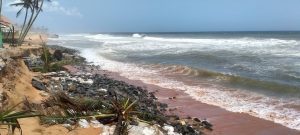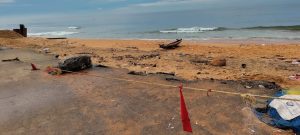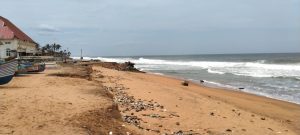The fishing community loses its land and livelihood as coastal erosion worsens in and around the Kerala capital.

Villages in Thiruvananthapuram district, especially in the 5 km stretch between Muthalappozhi and Anjengoing, are losing their sandy beaches along with homes, boats, and sometimes fishers’ lives (KA Shaji/South First)
The road to Anjengo is narrow and broken. Waves splash over the seawall, the salty spray and monsoon air fogging up our car’s windscreen. It is a surreal setting: Bare walls of broken houses looming against a grey sky.
As we stop, an elderly woman approaches us from the other side of the road, where fishing boats are docked in the lagoon. “Go and show them that we live like this,” she says, noticing our cameras.
Others join to share tales of fear and hope on this sliver of a barrier beach barely 30 km north of the centre of Thiruvananthapuram.
Seawalls made of granite blocks protect their villages, but waves shovel out sand from the base of these walls and sink them.
Erosion has become worse since a fishing harbour was built at the Muthalapozhi estuary where this stretch begins.
Scientists say that waves, tides, currents, rainfall, storms, and sea level change the shape, position, and orientation of shorelines. So does construction on the coast.

Erosion has become worse since a fishing harbour was built at the Muthalapozhi estuary in Thiruvananthapuram district (KA Shaji/South First)
Seawalls, breakwaters, and groynes built to protect harbours and ports affect the flow of beach material — pebbles, sand, mud, and shingles — depending on the nature of the coast. This sideways sediment movement is spurred by waves crashing at an angle.
When the rains start in June, high and steep waves hit the beach, carving out chunks of land. The beach changes with more rain spells and breaks, wind, and waves. When the fair weather season starts after the festival of Onam, slow waves from distant seas help the beach build back again with the sediment that the sea had taken away.
In Thiruvananthapuram, sediment transport during June-August is southwards, and for the remaining period, largely towards the north. When rocks or stones block this beach-building process, there will be erosion on the northern side.
This is what happened in the 5 km stretch between Muthalappozhi and Anjengo. Villages here are losing their sandy beaches, along with homes, boats, and sometimes fishers’ lives.

Remains of boats that have crashed against the breakwaters or capsized in the unpredictable estuarine waves have washed up on the shore (KA Shaji/South First)
Remains of some of the dozens of boats that have crashed against the breakwaters or capsized in the unpredictable estuarine waves have washed up on the shore. Fading pictures posted on shop walls announce the wake of yet another young man dead at sea.
People still catch and sell fish. Their children go to schools and colleges and become doctors, engineers, and fashion designers. Youth ride trendy scooters and motorbikes –– Enfield Bullet, KTM Duke, Yamaha FZ…
Fishing can be profitable, despite all the risks involved in it.
On the seashore of Anjengo, Vincy Lopez and Bennet John walk precariously over the rubble of a row of houses razed to the ground, looking for a good camera angle. They are shooting a documentary on the diversity of Thiruvananthapuram’s coast.
The place looks bombed out, concrete slabs on rusted metal rods dangling over canted tiled floors and broken walls.
We look for the spot where the house of Susa Melkias, an old friend, stood. On a calm day in April 2018, waves triggered by a severe storm in the Southern Ocean 9,000 km away travelled for five days as power-packed “long-period swell waves” and crashed onto the shore, destroying many houses.

More than a quarter of the coast of Thiruvananthapuram is vulnerable and three quarters are sensitive to erosion (KA Shaji/South First)
Another instance of kallakkadal, meaning stealthy sea in Malayalam. Susa built a new house with a government grant and borrowed money. He left fishing and now works in Kuwait.
More than a quarter of the coastline of Thiruvananthapuram is vulnerable and three-quarters are sensitive to erosion. Even parts of the coast protected by sea walls north of Vizhinjam such as Panathura, Poonthura, Beemapally, and Valiathura are highly prone to erosion.
Erosion in Thiruvananthapuram is caused largely by badly designed and maintained coastal protection structures, and breakwaters built without rigorous and reliable impact assessment, scientists note.
In the evening, Bennet and Vincy relax on their village beach at St Andrew’s, midway from Anjengo to the city. Young men and women run and walk and children play on the open beach, safely away from the crashing waves. Couples pose for photos against the crimson evening sky.
Local fishers and those from nearby places safely launch and land their boats here. More fishers come in trucks and engage in shore seine fishing, singing “Aylesa…”. Back in Beemapally, their beaches are severely stonewalled and eroded. A shore seine unit can engage over 30 fishers, even the elderly and those who dare not go into deep waters.
Such open, sandy beaches are highly valued.
As erosion worsens in villages north of Vizhinjam, including the tourist spots of Kovalam and Shankhumukham, scientists call for more detailed environmental impact studies and people-friendly planning.
Politicians, however, glibly say erosion is an old story. They then blame it on climate change and shy away from lasting solutions.
Fishers have launched a protest movement against the destruction of their coasts and livelihoods. Hope remains.
(Max Martin is a geographer researching marine weather, climate change and people’s responses. He has reported science for leading publications and won the Prem Bhatia award for environmental journalism. He lives in Bengaluru. These are the personal views of the author)

Jul 26, 2024

Jul 26, 2024

Jul 25, 2024

Jul 25, 2024

Jul 25, 2024

Jul 24, 2024